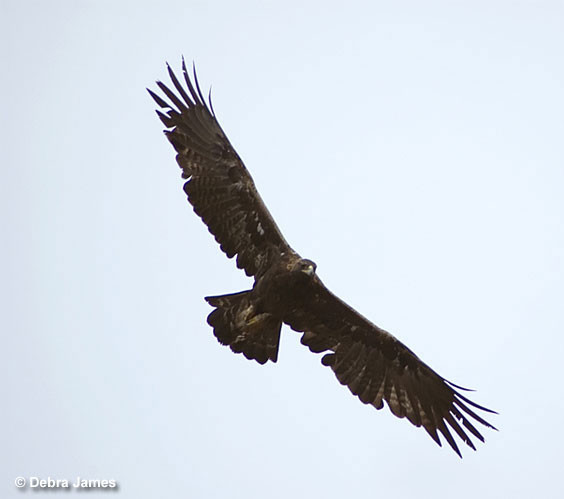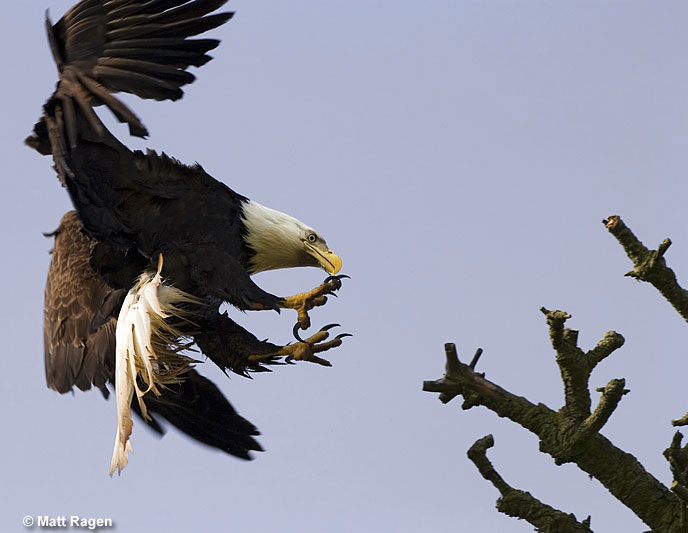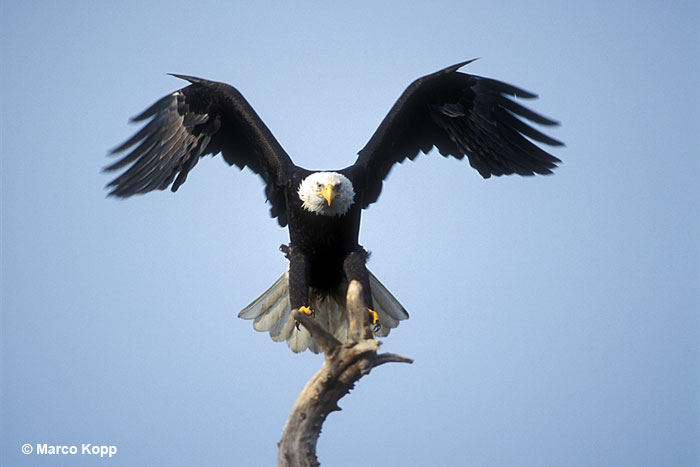Golden Eagle and Bald Eagle – these two eagles are the only to regularly occurring eagles in North America. Even better, in some places, they are pretty common and easy to see!
It’s easy to recognize adult Bald Eagles by their white head and tail. Golden Eagles are mostly dark brown although young birds have some white in their tail and wings. Immature Bald Eagles can be a bit more challenging but, if you know what to look for, you can still identify them.
Want to learn all about these two eagles and more field marks to recognize them?
On this page
Body & Shape
Bald Eagles and Golden Eagles are big raptors with long, broad wings. However, with a closer look, we can see that Bald Eagles soar with their wings held flat, sort of like a “flying board.” Golden Eagles, on the other hand, usually hold their wings in a shallow “V” shape.

Golden Eagle
Adults of both eagles also have dark brown plumage, although Bald Eagles have a bright white head and tail, and a big yellow beak. Adult Golden Eagles have a big, hooked beak, but it’s a bit smaller. Both birds also have big feet with long, intimidating talons.
Another difference between adult birds is that Golden Eagles have a buffy undertail, an indistinct dark tip on their tail, and golden highlights on their head and upper wings.

Pair of Bald Eagles. The female is on the left, male is on the right.
Young birds can be tricker to recognize, especially young Bald Eagles. They don’t have a white head or tail but can still be recognized by blotchy white markings on their wings and tail.
Immature Golden Eagles are easier to identify. They have a black and white tail with a broad black tip, and a white patch on each wing. As with Golden Eagles of all ages, they also show golden highlights on their head and the back of their neck.

Juvenile Bald Eagle
Golden Eagle vs Bald Eagle Size
Both types of eagles in North America are huge birds! A few other birds in North America are larger, but Bald and Golden Eagles are definitely the most powerful birds in Canada and the USA.
As with most other raptors, females of both species are larger than males. Some female Golden Eagles can measure a bit more than three feet in length, while big female Bald Eagles can reach a similar size.
In general, they are pretty similar in size, with Bald Eagles being around 31 inches long and Golden Eagles in North America being 30 inches.
Related: How big are Bald Eagles?
Golden Eagles tend to be a bit heavier than Bald Eagles. Their average weight is 10 pounds, while Bald Eagles average 9.5 pounds. However, the biggest female Bald Eagles can weigh as much as 13.9 pounds and the heaviest Golden Eagle was a massive 15-pound bird from the Himalayas!
The wingspans of these big birds of prey are also similar. Bald Eagles soar on wings that can span more than six and a half feet, and large females can have wingspans that surpass 7 feet! Golden Eagles take to the skies with a 6-foot wingspan, although some big female Golden Eagles can have wings that span 7 and a half feet.
Speed
Both eagle species are big bulky birds with long, broad wings, but they can also fly surprisingly fast. Bald Eagles fly with deep flaps and then glide for a few seconds. When leisurely flying like this, they don’t usually go faster than 35 miles per hour.
However, when they want to really move between one place and another, Bald Eagles can fly as fast as 45 miles per hour. With a tailwind, they can reach greater speeds and, when hunting, can dive at 75 to 100 miles per hour!

Golden Eagle soaring in the sky
While hunting, these big birds can be surprisingly agile, although they also frequently soar in slow, lazy circles high above their wetland habitat.
Golden Eagles fly in a similar fashion, usually making a few deep flaps interspersed with glides. However, they are also masters of flight and can soar, dive, and chase prey at high speeds. When flying from one spot to the next, they have a leisurely pace of 30 miles per hour but can switch into much faster “gears” when necessary.
As a Golden Eagle glides toward its prey, the bird can attain 120 miles per hour. However, when diving at a crane or other large bird, these raptors can move as quickly as 200 miles per hour!
Age
Bald Eagles and Golden Eagles have similar lifespans. In the wild, adults of both species tend to live for around 20 years. However, a number of wild eagles probably live much longer, even more than 30 years. One recaptured, banded Bald Eagle was 38 years old and the oldest known wild North American Golden Eagle lived to be 32.
In captivity, one Bald Eagle lived for almost 50 years, while the oldest captive Golden Eagle was 46.
In the wild, as with other raptors, many Golden and Bald Eagles die in their first year of life. For some places, 50% of young Bald Eagles don’t live longer than one year, while half of Golden Eagles may die by two years of age.
Young eagles in some areas have higher rates of survival, but in some other regions, 75% can die before the age of 5. However, if an eagle can live longer than that, it has a good chance of living to 20 or more.
More eagles die in their first year of life because they don’t learn to hunt well enough or are killed when competing with more experienced adult eagles. In the nest, they can also be vulnerable to Raccoons and other nest predators.
Golden Eagle vs Bald Eagle: Behavior
Eagles can occur as pairs or on their own. Both species spend much of their time establishing a territory and hunting for food. After leaving their nest, young Bald and Golden Eagles wander until they find a place of their own.
If they don’t move away from their parent’s territory, they are eventually driven away. While searching for a place to live, such young birds can wander quite far. During that time, they can be frequently chased away by other eagles protecting their own territories.

However, once they have adult plumage and find a mate, both birds establish and defend a set territory. Both species are mostly aggressive with other intruding eagles except when nesting. To keep their young safe, Bald and Golden Eagles won’t hesitate to dive at predators and people climbing to their nest.
Related: Do eagles mate for life?
Since they have been known to chase away animals as large as Black Bears, climbing to an eagle nest can certainly be dangerous! However, they won’t attack people on the ground who are within sight of their nest.
Whether near a nest or not, it’s a different story for small pets. Although it rarely occurs, both species of eagles have caught and killed small dogs and cats!
Golden Eagle vs Bald Eagle Diet
This is one of the main differences between Bald and Golden Eagles and probably explains why these two species can live in the same area. Although they can also overlap in some of the animals they catch, Bald Eagles tend to eat more aquatic animals than Golden Eagles.
Bald Eagles feed on a large number of fish, and flocks of Bald Eagles can even congregate at salmon spawning sites in northwestern North America. In such places, they feast on dying and dead salmon. They also eat other types of carrion and snatch fish from the water with their talons. In winter, Bald Eagles can be important predators of ducks, geese, and other waterbirds.
On occasion, Bald Eagles also catch mammals and other birds, but not nearly as much as the Golden Eagle. This species is a powerful predator that mostly catches mammals up to the size of a fox and birds as large as a heron.
Golden Eagles catch their prey by watching from a perch or soaring high overhead and then quickly gliding down to attack the animal with their talons. In some mountainous areas, they even knock goats off cliffs to feed on their carcasses far below!
Location
Both eagles can occur in the same places. However, Golden Eagles prefer wilder, more remote areas than Bald Eagles. The Bald Eagle is essentially a raptor of wetland habitats. They are quite adaptable and can live near freshwater and saltwater marshes, and along rivers, lakes, and reservoirs.
Related: Are Bald Eagles still endangered?
As long as wetlands with nesting sites are present, we can even see them in urban areas. Thanks to the prohibition of DDT, official protection, and lots of conservation work, Bald Eagles have become common in Alaska, large areas of Canada, and in many parts of the lower 48 states.

In winter, Bald Eagles from northern areas migrate to southern Canada and the USA. For many areas, this is the best time to see them, especially at dams and other places where numbers of Bald Eagles can congregate.
In North America, Golden Eagles mostly live in wild, semi-open habitats in Alaska, western Canada, and the western USA. A small population also breeds in wild northern regions of eastern Canada, and winters in scattered, forested areas of the eastern USA.
Such birds can be seen at migration hotspots in the eastern USA in late fall and early spring. However, Golden Eagles are much easier to see in the western states and provinces.
Nest & Eggs
Bald Eagles make bigger nests than most birds. Their huge, bulky nests are made of sticks and other objects, and can weigh as much as a ton! They add to them each year and nests can measure 8 feet in diameter and 13 feet deep!
This species nests in big trees, other platforms, and on cliffs near wetlands, and lays one to three dull white eggs. They are 2.9 inches long, 2.1 inches wide, and weigh 4.4 ounces. Both parents incubate them for five weeks and the young birds stay in the nest for around 3 months.

Baby Eagles in the nest. Both species have similar nests.
Golden Eagles also build large nests that average 6 feet in diameter and two to three feet deep. They make them out of sticks, bones, and other objects and usually build them on cliffs or trees. As long as there is a good view of their surroundings, Golden Eagles can also nest on big trees and human-made structures.
This raptor lays one to three, pale pink or white eggs with some brown markings. The eggs are 3 inches long, 2.1 inches wide, weigh 3.5 ounces, and are incubated by both parents for 42 days.
After hatching, the baby eagles can stay in their nest for 45 to 81 days.
Golden Eagle vs Bald Eagle – Frequently Asked Questions
Which is bigger, a Golden Eagle or a Bald Eagle?
Bald Eagles tend to be slightly larger than Golden Eagles. However, they are pretty similar in size and huge birds that can be more than 30 inches long.
How rare is a Golden Eagle?
A Golden Eagle is locally rare bird. In the western part of their range, Golden Eagles are uncommon but regularly seen in wild areas. In the east, they are much rarer and usually seen during migration.
How rare are Bald Eagles?
Bald Eagles are not rare. Although they became rare in many places during the first half of the 20th century, Bald Eagles have become common birds of wetland habitats in many parts of North America.
Which eagle is stronger?
Golden Eagles and Bald Eagles are similar in size and strength. Both have a very strong grip that can attain 400 pounds per square inch!


